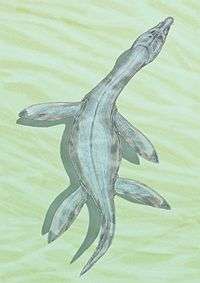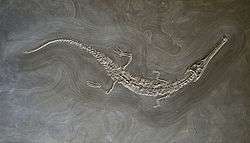Toarcian
| System/ Period |
Series/ Epoch |
Stage/ Age |
Age (Ma) | |
|---|---|---|---|---|
| Cretaceous | Lower/ Early |
Berriasian | younger | |
| Jurassic | Upper/ Late |
Tithonian | 145.0–152.1 | |
| Kimmeridgian | 152.1–157.3 | |||
| Oxfordian | 157.3–163.5 | |||
| Mid/ Middle |
Callovian | 163.5–166.1 | ||
| Bathonian | 166.1–168.3 | |||
| Bajocian | 168.3–170.3 | |||
| Aalenian | 170.3–174.1 | |||
| Lower/ Early |
Toarcian | 174.1–182.7 | ||
| Pliensbachian | 182.7–190.8 | |||
| Sinemurian | 190.8–199.3 | |||
| Hettangian | 199.3–201.3 | |||
| Triassic | Upper/ Late |
Rhaetian | older | |
| Subdivision of the Jurassic system according to the IUGS, as of July 2012. | ||||
The Toarcian is, in the ICS' geologic timescale, an age or stage in the Early or Lower Jurassic. It spans the time between 182.7 Ma (million years ago) and 174.1 Ma.[1] It follows the Pliensbachian and is followed by the Aalenian.[2]
The Toarcian age began with the Toarcian turnover, the extinction event that sets its fossil faunas apart from the previous Pliensbachian age.
Stratigraphic definitions
The Toarcian takes its name from the city of Thouars, just south of Saumur in the Loire Valley of France. The stage was introduced by French palaeontologist Alcide d'Orbigny in 1842, after examining rock strata of this age in a quarry near Thouars.
In Europe this period is represented by the upper part of the Lias.
The base of the Toarcian is defined as the place in the stratigraphic record where the ammonite genus Eodactylites first appears. A global reference profile (a GSSP) for the base is located at Peniche, Portugal. The top of the stage is at the first appearance of ammonite genus Leioceras.
In the Tethys domain, the Toarcian contains the following ammonite biozones:
- zone of Pleydellia aalensis
- zone of Dumortieria pseudoradiosa
- zone of Phlyseogrammoceras dispansum
- zone of Grammoceras thouarcense
- zone of Haugia variabilis
- zone of Hildoceras bifrons
- zone of Harpoceras serpentinum
- zone of Dactylioceras tenuicostatum
Palaeontology
†Ornithischians
| Ornithischians of the Toarcian | ||||
|---|---|---|---|---|
| Taxa | Presence | Location | Description | Images |
| Germany | Armored dinosaur known from a skull and partial postcranial remains, although only the skull is known well. Armor includes conical scutes and tall, spiny elements. | |||
†Plesiosaurs
| Plesiosauria of the Toarcian | ||||
|---|---|---|---|---|
| Taxa | Presence | Location | Description | Images |
| Tournemire, Aveyron, France | A plesiosaur similar to Elasmosaurus; fossils consist of a single but nearly complete skeleton of an animal approximately 4 meters (13 ft) long | |||
| Toarcian | Württemberg, Germany | A large (about 3 to 5 meters long), marine sauropterygian reptile, it was distinguished by its small head, long and slender neck, broad turtle like body, a short tail, and two pairs of large, elongated paddles | ||
| Toarcian | Alum Shale, Yorkshire, England | A genus of sauropterygian carnivorous reptile belonging to the pliosaur superfamily, it was about 7m long. | ||
†Sauropods
| Sauropoda of the Toarcian | ||||
|---|---|---|---|---|
| Taxa | Presence | Location | Description | Images |
| Maharastra, India | Reached a length of about 18 metres (60 feet), and weighed about 48 tones (53 tons). Its height to the hip was approximately 5.5 metres (18 feet) | |||
| Disputed | Central Queensland, Australia | Estimated to have been about 12–15 metres long. Has been compared to Shunosaurus, based on similar general age, but without justification. | ||
| Toarcian | Ouarzazate province, Morocco | Small primitive sauropod, about 9 metres long. Member of Vulcanodontidae family.[3] | ||
†Thalattosuchians
| Thalattosuchia of the Toarcian | ||||
|---|---|---|---|---|
| Taxa | Presence | Location | Description | Images |
| Somerset, England; France; Germany |
| |||
| Germany | ||||
| Germany; France; England; Morocco; and Switzerland | ||||
References
- ↑ Benton, Michael J. (2012). Prehistoric Life. Edinburgh, Scotland: Dorling Kindersley. pp. 44–45. ISBN 978-0-7566-9910-9.
- ↑ For a detailed geologic timescale see Gradstein et al. (2004)
- ↑ Allain, Ronan; Najat Aquesbi; Jean Dejax; Christian Meyer; Michel Monbaron; Christian Montenat; Philippe Richir; Mohammed Rochdy; Dale Russell; Philippe Taquet (2004). "A basal sauropod dinosaur from the Early Jurassic of Morocco". Comptes Rendus Palevol. 3 (3): 199–208. doi:10.1016/j.crpv.2004.03.001. ISSN 1631-0683.
Sources
- Gradstein, F.M.; Ogg, J.G. & Smith, A.G.; 2004: A Geologic Time Scale 2004, Cambridge University Press.
- d´Orbigny, A.C.V.M.D.; 1842: Paléontologie française. 1. Terrains oolitiques ou jurassiques, Bertrand, Paris. (French)
External links
- GeoWhen Database - Toarcian
- Lower Jurassic timescale, at the website of the subcommission for stratigraphic information of the ICS
- Stratigraphic chart of the Lower Jurassic, at the website of Norges Network of offshore records of geology and stratigraphy
| Jurassic Period | ||
|---|---|---|
| Lower/Early Jurassic | Middle Jurassic | Upper/Late Jurassic |
| Hettangian | Sinemurian Pliensbachian | Toarcian |
Aalenian | Bajocian Bathonian | Callovian |
Oxfordian | Kimmeridgian Tithonian |



